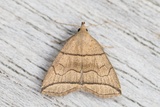Herminia grisealis ([Denis & Schiffermüller], 1775) Species
Last modified: Oct. 16, 2025, 6:29 p.m.
A rather common species throughout Belgium.
This species is considered Least Concern according to the IUCN Red List category for Flanders 2023.
Details
- Classification
- Family: Erebidae > Subfamily: Herminiinae > Genus: Herminia > Species: Herminia grisealis
- Vernacular names
- Boogsnuituil (NL), Small Fan-foot (EN), L'Herminie grise (FR), Bogenlinien-Spannereule (DE)
- Synonyms
- Herminia nemoralis (Fabricius, 1775), nec (Scopoli, 1763)
- First mention in Belgium
- De Sélys-Longchamps E. 1844. Énumération des insectes Lépidoptères de la Belgique. — Mémoires de la Société royale des Sciences de Liége 2: 1–35. On page 19 (as Herminia grisealis). view page
- Status
-
Native
Distribution
Bionomics
Hibernates as a pupa, in a cocoon formed in a bark crevice or among plant debris. The adults become active from dusk onwards and later come to light and sugar.
No pictures yet!
Flight periods
The adults fly in one generation a year from mid-May till mid-August. Sometimes a partial second generation occurs till early October.
Observed on
- Host plant (species):
- Alnus glutinosa and Tilia cordata
- Host plant (genera):
- Quercus, Betula, Corylus, Crataegus and Urtica
The larva lives on deciduous trees and shrubs including Quercus, Alnu, Crataegus, Corylus, Rubus, Prunus padus and Clematis vitalba, even on the the fallen leaves.
No pictures yet!



